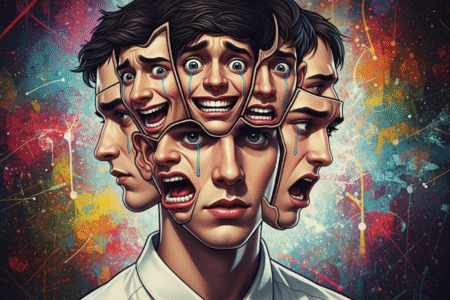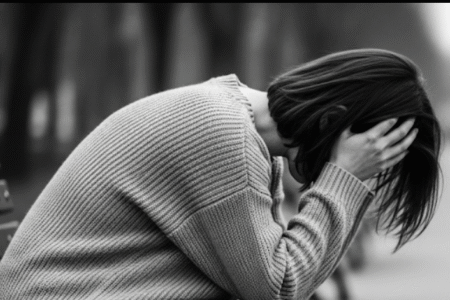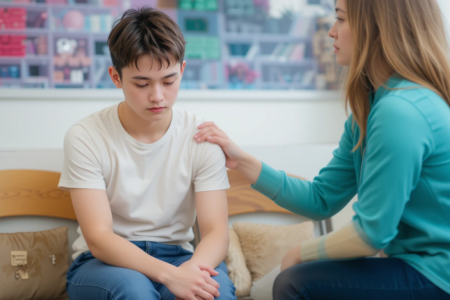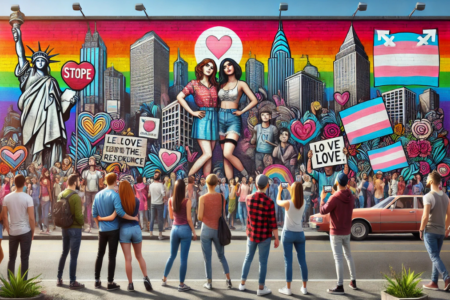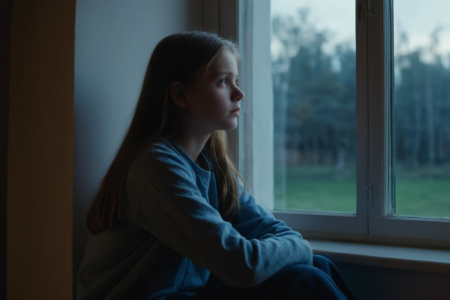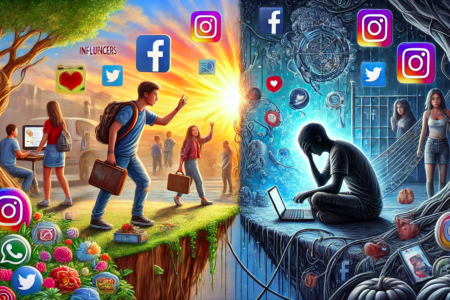In Part 1, we opened the door to understanding mental illness by challenging stigma, exploring its impact, and urging early awareness. Now, in Part 2, we step deeper into the world of mental health — exploring the types of mental illnesses, their hidden presence in daily life, and the critical need for treatment and support. Each story of mental illness is unique, yet many share similar patterns that often go unnoticed. Understanding these nuances can help us become more empathetic, informed, and supportive as a society. Mental illnesses are not one-size-fits-all. They range from mild disruptions in mood or thinking to severe conditions that drastically impact everyday functioning. Broadly, mental disorders fall into categories like mood disorders, anxiety disorders, psychotic disorders, eating disorders, and personality disorders. Among the most common is depression, which can bring overwhelming feelings of sadness, fatigue, hopelessness, and even physical pain. Then there’s anxiety, which is more than just nervousness — it’s a persistent fear or dread that can make even simple tasks feel impossible. Bipolar disorder causes intense mood swings, from emotional highs (mania) to crushing lows (depression), while schizophrenia involves hallucinations, delusions, and a distorted sense of reality. Obsessive-compulsive disorder (OCD) and post-traumatic stress disorder (PTSD) also fall into this complex web, each with its own triggers, symptoms, and challenges. These conditions don’t always show themselves clearly. In fact, mental illness is often hidden in plain sight. A student who is always anxious about failure, a colleague who seems unusually withdrawn, or a loved one who jokes about being tired all the time — these may be quiet cries for help. Unfortunately, our fast-paced lifestyles and societal expectations can discourage people from pausing to acknowledge these signs. We’re taught to “keep going,” to “stay strong,” to “not overthink” — phrases that, while well-intentioned, often invalidate the very real struggles people face internally. Adding to this complexity is the influence of society and culture on how mental illness is viewed. In many cultures, mental health remains a taboo subject. Admitting to a mental health condition is often equated with being “weak” or “unstable,” making individuals reluctant to seek help. Some families may deny the presence of a disorder altogether, dismissing it as a phase, laziness, or drama. In workplaces, the pressure to appear “professional” often discourages people from speaking up about burnout or emotional exhaustion. This silence and shame can delay treatment, worsen symptoms, and sometimes lead to tragic outcomes. But here’s what we must remember — help is available, and healing is possible. Treatment options for mental illness are more diverse and accessible than ever. These include therapy, counseling, medication, support groups, lifestyle changes, and more recently, online mental health platforms. Therapists and mental health professionals are trained to create safe, non-judgmental spaces where individuals can explore their thoughts and emotions. Contrary to popular belief, therapy is not just for people in crisis — it’s for anyone who wants to understand themselves better, improve coping strategies, and live a more balanced life. The journey to recovery may not be linear. There may be relapses, moments of doubt, and emotional setbacks. But with the right support system — friends who listen, families that understand, workplaces that care, and professionals who guide — it becomes easier to manage and live fully. Mental illness doesn’t have to define who someone is; it is simply one part of their human experience. In the next part of this series, we will focus on how you can support someone living with mental illness — what to say, what not to say, how to truly be there, and why even small acts of kindness can be life-changing. We’ll also explore how to build a mentally healthy environment at home, in schools, and at workplaces. Because the fight against mental illness isn’t just personal — it’s collective. We often wonder what to do when someone we care about is struggling — Do I say something? Should I give them space? What if I make it worse? These questions can feel overwhelming, and many of us stay silent out of fear of saying the wrong thing. But silence can sometimes speak louder than words. In Part 3, we’ll unlock the emotional toolkit everyone needs — how to offer real support, how to be a safe space, and how your words, actions, or even quiet presence might be the one thing that changes someone’s life. What does it truly mean to “be there” for someone battling a storm you can’t see? The answers may surprise you. So keep reading FORAMZ.
Mental illness is one of the most misunderstood and overlooked health issues in society today. Despite growing conversations around mental health, many people still shy away from discussing their struggles, fearing judgment or misunderstanding. In a world that often prioritizes physical health and outward success, the inner battles people face remain hidden. But the truth is, mental health is just as important as physical health, and it’s time we break the silence surrounding it. Mental illness refers to a range of mental health conditions that affect mood, thinking, and behavior. These include common disorders like depression and anxiety, as well as more complex conditions such as bipolar disorder, schizophrenia, and post-traumatic stress disorder (PTSD). Each individual’s experience with mental illness is unique, with some needing short-term support, while others may require lifelong care and understanding. What’s important to remember is that mental illness is not a choice, a phase, or a weakness — it is a legitimate health condition that deserves compassion and proper treatment. The need to address mental health has never been more urgent. According to the World Health Organization, one in every eight people globally is living with a mental disorder. This number has been rising steadily, especially in the aftermath of the COVID-19 pandemic, which brought with it a wave of anxiety, loneliness, and emotional exhaustion. Children, teenagers, working professionals, and even the elderly — no age group has been spared. Unfortunately, even with such alarming statistics, awareness and access to help remain limited, and societal stigma continues to silence those who need support the most. Recognizing the signs of mental illness is the first step toward healing. Warning signs can include persistent sadness, withdrawal from social activities, drastic mood changes, sleep disturbances, overwhelming anxiety or fear, and trouble concentrating. In more serious cases, individuals may even experience thoughts of self-harm or suicide. These signs should never be ignored or brushed aside as “just a bad day” or “attention-seeking.” Just like we rush to help someone with a physical injury, the same urgency must apply to mental health crises. Perhaps the most harmful myth is that mental illness reflects personal weakness or failure. Nothing could be further from the truth. Mental health conditions often arise due to a complex mix of genetics, environmental factors, trauma, and brain chemistry. No one chooses to struggle, just like no one chooses to fall physically ill. What people battling mental illness need is not pity or advice, but empathy, understanding, and support. They need safe spaces to open up without fear of being judged. Mental illness doesn’t always look the way we expect it to. Sometimes it wears a smile in public and cries behind closed doors. It can be hidden in high achievers, busy parents, quiet teenagers, or even the friend who’s always making everyone laugh. This invisibility is what makes awareness so crucial because people often suffer in silence, even when surrounded by others. In the next part of this series, we’ll uncover how these hidden struggles manifest, the different forms they take, and why understanding them is key to creating a more compassionate and mentally healthy society. As we begin to peel back the layers of what mental illness truly means, one thing becomes clear — there’s so much more beneath the surface. Why do certain disorders go undiagnosed for years? What roles do culture, upbringing, and media play in shaping our beliefs about mental health? And most importantly, what does healing really look like in today’s fast-paced, hyperconnected world? In Part 2, we’ll dive deeper into the types of mental illnesses, how they silently affect daily life, and why seeking help is both brave and necessary. Stay with us — the conversation is just getting started. For more interesting content, keep reading FORAMZ.
Welcome back to Foramz, your go-to place for stories that speak truth, offer comfort, and sometimes, show us another way. In the last episode of student loans, we met Stewart- a dreamer with his heart set on Texas University. But like thousands of students choosing the so-called American Dream, Stewart found himself drowning before even setting sail. The tuition fee? $31,572. The weight is Unbearable. The future is unclear. But does that mean the dream of Stewart ends here? In the last episode, we met Stewart, a dreamer with his heart set on Texas University. But like thousands of students chasing the so-called American Dream, Stewart found himself drowning before even setting sail. The tuition? $31,572. The weight? Unbearable. The future? Unclear. But Today’s story is different. This is about what happens when the dream evolves and does not die. When you realize that success isn’t always tied to an expensive name tag, but rather, to strategy sanity and sustainability. In this story, we will explore how a dream can come true with changing environments. A dream can easily evolve through life’s problems and worries. This This is Formaz, and we are looking for moral solutions in he fast-paced world. The night that Stewart sat scrolling in silence, something in him shifted. The more he read about students choosing alternative routes, the routes that did not involve debt the size of a house mortgage more he wondered, Could he bring his dream to reality without burning down his present financial condition? So very diligently and with determination, he got to work. Not just on applications, but on research. He discovered that many successful professionals in the U.S. began at community colleges, paying a fraction of the cost and transferred later to finish their degrees at prestigious universities. He thought, why not spend the first two years close to home or in a smaller town, build his GPA, and then transfer to a top-tier university when it counts? The cost? Less than one-third of the full four-year degree. Tuition-Free or Low-Fee Nations Then Stewart looked overseas—but not to the U.S. Germany, Norway, and even certain Eastern European nations provide tuition-free education to foreign students, with English-language programs. Yes, it meant getting used to a new culture. But wasn’t that part of the dream as well? More significantly, it meant no debilitating debt and the opportunity to pursue what he wanted to study. Another surprised him: how online learning had progressed. No longer was it merely a backup, now some of the largest organizations (Google, Amazon, Meta) have begun accepting skills-based certification from platforms such as Coursera, edX, and even their scholars. He used to think, if it is what you can do that counts, why not acquire skills wisely and cheaply without depleting the nest egg of the house. What shifted most for Stewart wasn’t so much his educational path. It was his mindset. He no longer perceived the cost of a university as a reflection of his value. He knew that real success isn’t where you attend school—it’s what you choose to do with what you know. A Message to Students Everywhere If you’re hearing this feeling anxious, stuck, or embarrassed because you can’t afford your dream school, stop. Is there another way to the same destination? Because the chances are- yes, there is. And it could just save years of debt, stress, and regret. The world is changing. Education is changing. And your future isn’t on one single path. Just like Stewart, you can make smart choices and win differently. So choose skills and alternative ways rather than being burdened by the pressure of loans and debts. Educate yourself on ways to educate yourself. The statement might sound somewhat contradictory, but it is true. Students are unaware of the possible ways through which one can learn and make a fruitful career. The world is full of opportunities and varied ways of learning a skill. Hence, dive deep into the pool full of learning opportunities and find some ways that will give you favourable results. Results are not just in exams, but the results of a fruitful life. 2. Indulge in the course with active attention and focus 3. Ask for help whenever required 4. Learn as if you are learning for your career and not just to gain the certificate or pass the exam 5. Test yourself on concepts 6. Get the certificate or degree and apply wisely in the practical world. These were some alternative ways of how to rid yourself of the evil of student loans. If you are someone growing in student loans do not worry because you are not alone. Know that the universe has got a pth for you and that everything will eventually be fine. There are various career opportunities and in the end, you will end up with something that you love doing. If you feel drained or demotivated at any time, then Keep Reading Foramz.
In the previous part of this, we discussed the psychological wounds that are left on teenagers due to bullying and abuse. The silent battle victims fight every day, the scars unseen by the world. But awareness alone is not enough we need action. It’s time to shift from identifying the problem to finding real solutions that can heal and protect teenagers from abuse. Creating a Safe Space: The Power of Open Conversations Silence is an abuser’s greatest ally. Many teenagers suffer in silence, fearing judgment, retaliation, or disbelief. We must break this silence by creating environments where they feel safe to share their struggles. Strengthening the Shield: Building Confidence One of the most effective ways to prevent and combat teenage abuse is by empowering victims. Strengthening their self-worth and confidence can make them less susceptible to emotional breakdowns caused by bullying. Enforcing Accountability: Holding Bullies & Abusers Responsible Stopping teenage abuse requires firm actions against those who perpetrate it. Many bullies continue because they face no real consequences. Healing the Wounds: Support & Therapy Victims of abuse often suffer long-term emotional distress. The healing process requires professional and personal support. Uniting as a Society: The Role of Parents, Schools, & Communities Ending teenage abuse isn’t an individual fight—it’s a collective responsibility. When parents, teachers, schools, and communities work together, real change happens. The Path Forward Teenage abuse can no longer be an unspoken issue. Every effort counts from the smallest conversation to policy changes at a national level. Parents, teachers, peers, and society must come together to create a world where every teenager feels safe, heard, and valued. In the next part of this, we will explore real-life stories of survivors stories of strength and victory. Because no matter how dark the tunnel is, there is always light at the end of it. The battle against teenage abuse is not just about fighting the bullies it’s about healing the victims and building a future where no teenager suffers in silence. Keep reading Foramz for your daily dose of moral support.
Take a walk through a college campus, a metro station, or a coffee shop, and you’ll notice one thing in common Gen Z is almost always plugged in. Whether it’s music, podcasts, or ambient sounds, there’s a non-stop stream of audio flowing directly into their ears. Headphones have become more than a gadget. They’re an identity, an escape, and for some, a survival mechanism. But here’s a question arises that no one’s asking loudly enough: What is this constant soundscape doing to their mental and physical health? The 24/7 Audio Loop For Gen Z, silence has become uncomfortable. Many can’t fall asleep without white noise or “sleepy” Spotify playlists. Studying? That requires lo-fi beats or dark academia instrumentals. Even social media apps are audio-forward from TikTok sounds to voice notes. This creates a dangerous reality: the brain rarely gets a moment of pure silence. Experts are raising concerns. neurologists warn “The brain is not designed for non-stop stimulation. Young adults who are constantly plugged in are showing early signs of attention fatigue and reduced emotional resilience.” Hearing Loss Is Hitting Early Headphones might seem harmless, but loud volumes over long durations are a recipe for irreversible damage. According to a recent WHO report, over 1 billion young people worldwide are at risk of noise-induced hearing loss due to unsafe listening habits. What’s worse? Most Gen Z listeners don’t even realize they’re turning the volume up too high. Noise-cancelling headphones, a Gen Z favorite, create an illusion of safety. But many crank up the volume to overpower environmental sounds, exposing their ears to 85+ decibels for hours on end enough to cause permanent hearing loss. Ringing in the ears is no longer just an old person’s problem. It’s showing up in teenagers. And it’s more than just annoying it leads to sleep issues, anxiety, and even depression. Escape or Avoidance? Beyond physical health, there’s a bigger, more emotional question: Why is Gen Z so desperate to stay plugged in? Part of it is the desire to create a personal bubble a way to feel in control in an increasingly chaotic world. But this bubble often becomes a wall. Headphones are becoming tools for social avoidance. Eye contact is lost. Conversations are skipped. Silence is feared. This kind of emotional detachment can lead to loneliness, social anxiety, and difficulty navigating real-world relationships. In a paradoxical twist, Gen Z the most connected generation in history is increasingly disconnected in real life. Can We Unplug? The solution isn’t to throw out the headphones. Music, podcasts, and audio spaces have enormous power they inspire, educate, and even heal. But like all powerful tools, moderation is key. Most importantly, reconnect with the sound of silence. Listen to your surroundings. Engage in a real conversation. Let your brain breathe. Because sometimes, the most powerful moments happen when the music stops. Keep reading foramz for your daily dose of emotional support.
From the moment a beautiful woman steps into a room, all eyes turn to her. Strangers steal glances, some openly stares, some smile, smirk in creepy ways. Some look at them with hungry eyes like a predator. Some make assumptions solely on the looks of the woman. While society glorifies beauty, rarely does it acknowledge the psychological weight that comes with it. Many assume that being naturally attractive is an automatic confidence booster. However, self-confidence is an inner trait that requires self-work, and external validation can often feel more like a burden than an asset. The constant scrutiny that beautiful women face can lead to anxiety, discomfort, and even a sense of alienation. Imagine walking home on a busy street filled with people returning from work–men, women, and children all moving about. Despite the bustling environment, an attractive woman finds herself the subject of unsettling attention. She is scanned from head to toe by creepy stares, making her feel objectified rather than seen as a person. This is a reality many women endure daily, and it creates a sense of vulnerability and unease. This feeling of always being watched by people creates a sense of pressure an expectation to always look perfect act a certain way or live up to ideals projected onto the person. In today’s professional landscape, women continue to break barriers, shatter glass ceilings, and redefine success. However, for women who are perceived as conventionally attractive, the workplace can present a unique set of challenges. While beauty is often celebrated in society, it can also become a double-edged sword in professional settings, leading to biases, stereotypes, and unfair treatment. Women are often objectified as sources of gaining sexual pleasure. Sexual remarks are made on women and rape cases are everyday statistics today. Beyond the workplace, the objectification of women extends into daily life. Women are often viewed as sources of sexual pleasure rather than individuals with dreams, ambitions, and intellect. Sexual remarks, catcalling, and harassment have become normalized to the extent that many women feel unsafe in public spaces. Rape and sexual assault statistics continue to be alarming, highlighting the dangerous consequences of a society that prioritizes physical beauty over personal agency. While beauty is often considered an advantage, it carries its own set of burdens that society seldom acknowledges. The constant scrutiny, the pressure to meet expectations, workplace biases, and the reality of objectification create a challenging experience for many women. It is essential to foster awareness and challenge the cultural norms that perpetuate these struggles. True progress lies in appreciating individuals beyond their physical appearance and creating an environment where women are valued for their talents, intellect, and character rather than just their looks. While beauty is perceived as a blessing, it comes with its own set of woes that society hardly ever considers. The relentless criticism, the burden of expectation, biases in the workplace, and the harsh truth of objectification make it a difficult ride for most women. It is imperative to create awareness and challenge the cultural standards that fuel these challenges. Real progress is finding beauty in individuals beyond their external appearance and cultivating a society in which women are appreciated for their abilities, intellect, and qualities and not necessarily their physical attraction. This is Foramz.com and in the next part, we will be discussing how women face scrutiny under the public eye and are judged.
The struggles of the transgender youth are not mere individual struggles, but a symbol of the collective responsibility we bear as a society. Each of these stories of hurt, rejection, and struggles to define one’s self is an image of the collective responsibility we bear as a society. The Journey toward acceptance and inclusion is not solitary. The journey toward acceptance and inclusion is not a solitary one; it requires empathy, understanding, and a commitment to change. Today, let’s delve deeper into how we can continue to uplift transgender youth and ensure they feel like they truly belong in this world. The Power of Representation: Seeing Yourself in the World Representation counts. For transgender youth, watching individuals like them in the media, in politics, in sports, and in daily life can be transformative. It’s a strong message: You are not alone. Your identity is valid. You matter. Think of being a teenager grappling with your identity, looking through social media or watching television, and never seeing anyone like you. Lack of representation may be a deafening erasure, an affirmation of the anxiety that the world doesn’t want you. But when transgender folks are honored for all their queerness—when their lives are told with candor and integrity—it makes for a ripple of hope and potential. We must insist and fashioning welcoming spaces in which transgender voices are heard. It means we must stand behind transgender artists, writers, and creators. It means we must fight for respectful and accurate representations of transgender individuals in the media. Community Support: Creating Networks of Belonging While family and school are essential pillars of support, the wider community also has a crucial role in influencing the lives of transgender youth. While family and school are essential pillars of support, the wider community also has a crucial role. But support from the community does not have to exist only in LGBTQ+ environments. Neighbors, coworkers, friends, and even strangers- all can change the world. Small and gracious acts such as respecting someone’s pronouns or challenging transphobic comments, can be deeply impactful. When we appear to or transgender children, we communicate in no uncertain terms: You are not alone. We see you and we stand with you, and we are here for you. Education and Awareness: Breaking Down Barriers Ignorance is frequently the source of prejudice. Most of the difficulties faced by transgender young people are based on a lack of Ignorance is usually the origin of prejudice. Most of the issues transgender youth face are due to a lack of knowledge about what it is to be transgender. Learning is a great tool for breaking barriers and creating empathy. Schools, workplaces, and communities need to make education on gender diversity a priority. This involves educating youth on the range of gender identities, the value of honoring pronouns, and the damage of stereotypes and discrimination. It also involves educating educators, healthcare workers, and other professionals to be knowledgeable and affirming allies. But education doesn’t end at institutions—it begins with us. Take the time to learn about transgender issues. Listen to the experiences of transgender people. Challenge your own assumptions and biases. When we educate ourselves, we become better able to create a world where everyone feels respected and valued. The Role of Faith and Spirituality: A Source of Healing, Not Harm For most families, spirituality and faith are a core part of their existence. Sadly, religious doctrine is often used to legitimize rejection or discrimination against transgender teens. However, this doesn’t have to be the way things are. Faith can also be a force for love, compassion, and healing. Faith leaders and communities have a special chance to set an example of acceptance and inclusion. By affirming the inherent value and dignity of every person, regardless of gender identity, they can send a strong message of love and belonging. Most faith traditions already affirm the values of compassion and justice—it’s time to apply those values to transgender youth. The Ripple Effect of Allyship: Small Acts, Big Impact Allyship is not an event—it’s a way of life. It’s about being present, even when it’s hard. It’s about leveraging your privilege to center marginalized voices. It’s about being willing to challenge injustice, even when it’s convenient to remain quiet. Each action of allyship, no matter how small, has the potential to bring about change. Whether it’s calling out someone who misgenders a friend, fighting for inclusive policies at work, or just listening to a transgender young person’s story, these actions accumulate. They have a ripple effect that can change lives and communities. A Call to Action: Be the Change They Need The journey to acceptance is a long one, but it’s worth taking. Every step toward justice—every bit of kindness, every attempt at listening, every challenge to discrimination—gets us one step closer to a society in which transgender kids can survive. We have to be the change they require.We have to be their supporter, their champion, their steadfast ally. We have to build a world where no transgender child ever feels isolated, where every young person is cherished for precisely who they are. This is not only about transgender youth—it’s about all of us. It’s about the world we wish to inhabit: a world in which love wins over hate, compassion conquers prejudice, and every individual has the freedom to be who they truly are. Final Thoughts: A Future of Hope and Belonging The issues transgender youth are confronting are deep, but so is the possibility of transformation. With compassion, empathy, and action, we can have a future in which every child is loved, accepted, and valued. Let’s be part of that change. Let’s hear the testimonies of transgender young people, raise their voices, and join them in their struggle for justice and equality. Let’s create a world where no one has to hide themselves, and everyone can live with dignity and pride. Together, we can transform pain into hope, loneliness into belonging, and dreams into reality. Because every child
Imagine feeling so invisible, so lost, that you begin to question if anyone would even notice if you were gone. For 16-year-old Maya, this was her everyday reality. The constant pressure from school, the overwhelming loneliness, and the haunting feeling of being trapped each day felt like a silent battle. Maya had always been the quiet, creative type, but behind her calm demeanor was a storm she didn’t know how to fight. The pressure from school was suffocating. Her grades were falling, her friends seemed to be moving on with their lives, and her family’s expectations felt like an impossible mountain to climb. Every day, she felt like she was losing herself just a little bit more. It wasn’t just about school. It was the loneliness—the kind of loneliness that doesn’t go away even when you’re surrounded by people. Maya couldn’t talk to her friends because she didn’t know how to explain the suffocating sadness she was feeling. She didn’t want to burden her parents, who were already stressed with their own lives. So, Maya did what many teens do when they feel like no one’s listening: she bottled it all up. It wasn’t until one afternoon, when the weight of it all became too much, that Maya reached a breaking point. She found herself staring at the edge, considering whether it would just be easier to end the pain. The thoughts were loud, persistent, and terrifying. But then, something happened. It was a message. A simple “Hey, you good?” from her best friend, Riya. At first, Maya didn’t know how to respond. She hadn’t been answering calls or texts much, but for some reason, this one felt different. It wasn’t just a “Hey, what’s up?” it was a genuine check-in, an open door that Maya didn’t even realize she needed. Riya wasn’t trying to fix anything and wasn’t offering unsolicited advice. She didn’t even push Maya to talk. She just said, “I’m here for you. Whenever you’re ready to talk, I’ll listen.” A few days later, Maya finally took the first step. She reached out to her school counselor. It wasn’t easy. It took every ounce of courage she had left, but walking into that counselor’s office marked the beginning of her healing. That was the moment things began to shift for Maya. She didn’t open up right away, but that message planted a seed of hope. Someone cared. Someone noticed. Maybe it was worth sticking around to see what could happen next. Over time, therapy helped Maya untangle the mess in her mind. She learned coping mechanisms for the stress, the pressure, and the anxiety. It wasn’t a magic fix some days were still hard but she felt stronger. And through therapy, she discovered something that truly began to save her: her passion for painting. Painting had always been an escape, but Maya never thought of it as something she could rely on for healing. She started sketching again just little things at first, but they gave her a sense of peace. Over time, those little sketches turned into full paintings, each one more vibrant and expressive than the last. She painted her anger, her sadness, and eventually, her joy. Her canvas became a place where she could let it all out with no judgment, no expectations, just her, the brush, and the colors. Maya’s journey wasn’t perfect, but it was hers. She found hope in the smallest of things: a message from a friend, the courage to ask for help, and the power of self-expression through art. And now? Maya knows that even in the darkest times, there is a way back. She’s still learning, still healing, but she no longer feels trapped in a world where there’s no way out. To anyone reading this, remember this: You are never alone. There is always a way through, even when there isn’t. Whether it’s a friend reaching out or a counselor offering guidance sometimes, all it takes is a single step toward hope to change everything. If Maya could find light in the darkness, so can you. Keep reading foramz for your daily dose of emotional support.
Retirement. For years, it feels rewarding for all the hard work, sleepless nights, and decades of dedication – almost like a far-off fantasy. Relaxing, spending time with family, traveling, and waking up without an alarm sounds perfect. But what happens when that day finally arrives? Instead of peace, you get met with an uncomfortable sense of emptiness. Nobody talks about the hidden challenges that accompany retirement. The ones that sneak in slowly and manage to alter your golden years to something you never fantasized about. Let’s discuss the problems The Loss of Identity For decades, your job wasn’t merely a means of making money – it was a core part of your identity. But once retirement hits, that title vanishes. All of a sudden, you are just, well…you, and that’s quite scary. People stop asking for your advice, you’re no longer included in decisions, and the skills you once prided yourself on? They start feeling irrelevant. You might even find yourself wondering, Who am I without my job? It’s a painful realization, and it doesn’t go away overnight. The Dagger of Loneliness Even on the craziest days at work, there was always someone to talk to a colleague, a junior, a client, or even a coffee machine buddy. Retirement, however, takes away that daily social interaction. Suddenly, the house feels quieter. The phone rings less. Friends, busy with their own lives, seem distant. Well, at least family is available, but they have their schedules. Your children are balancing work and raising a family, your spouse (if you have one) might not empathize with your situation entirely, and Making new friends at this age? Well, it’s harder than it sounds. Loneliness creeps in, bringing along its best friend depression. The Financial Reality Check No matter how much you save, retirement often feels like a financial rollercoaster. The steady paycheck is gone, but the expenses? They don’t retire. Medical bills, house maintenance, unexpected emergencies—money suddenly feels fragile. And if you didn’t plan well or circumstances beyond your control drained your savings, the stress multiplies. Dependence on family, cutting down on long-cherished luxuries, or even considering a part-time job after retirement none of this feels good. The financial anxiety can be overwhelming, making every rupee spent like a ticking clock. The Health Decline Age catches up, no matter how healthy you were before retirement. The body slows down, minor aches turn into chronic pains, and medical check-ups become a regular part of life. Suddenly, you’re dealing with things like high blood pressure, joint pains, or worse, serious illnesses that demand constant attention. But it’s not just physical health mental health takes a hit too. Anxiety, depression, and memory issues can start showing up, making the post-retirement phase even tougher. And the worst part? Many suffer in silence, afraid to burden their loved ones with their struggles. The Feeling of Being Unwanted One of the hardest things about retirement is the unspoken truth society moves on. The workplace finds your replacement, younger generations take over, and suddenly, the wisdom and experience you spent years gathering seem to be… forgotten. You may feel like you’re just “there” in family gatherings, no longer the decision-maker or the go-to person for advice. The feeling of being sidelined, ignored, or simply not needed can be heartbreaking. And when you’re constantly reminded that the world is moving forward without you, it’s easy to feel invisible. The Absence of Purpose Work gave you a reason to wake up every morning. Deadlines, projects, and goals each day had a structure. But post-retirement? The days are long, and without a plan, they start feeling meaningless. Sure, hobbies sound great in theory, but not everyone finds fulfillment in gardening or reading. And if you’ve spent your entire life focused on work, shifting to life without deadlines can feel like being lost in an endless void. Many retirees wake up with no idea what to do, and that emptiness can be suffocating. Relationship Changes Retirement doesn’t just affect you it changes your relationships too. Spouses who once had their own space suddenly find themselves together 24/7, leading to unexpected tensions. Friendships can fade, especially if they are mostly tied to work. Even relationships with children shift, sometimes bringing a painful realization that you no longer play as big a role in their lives. These changes can feel like small heartbreaks, piling up over time, leaving you wondering if things will ever feel “normal” again. Final Thoughts Retirement is painted as a phase of relaxation and happiness, but for many, it’s a time of deep emotional and psychological struggle. These problems aren’t just “phases” they’re real, painful, and often ignored. In the next part, we’ll talk about ways to navigate this challenging time. But for now, if any of this resonates with you, just know you’re not alone. And your feelings? They’re valid. Keep reading foramz for your daily dose of emotional support.
In this digital age social influencers have become powerful figures shaping the thoughts, beliefs, and behaviors of young people worldwide. Unlike traditional celebrities, who gained fame through talent and years of experience, influencers are grabbing a hold of the social media platforms like TikTok, YouTube, and Twitter. They create content ranging from lifestyle, fashion, fitness, and entertainment to self-improvement, education, and activism. The name iInfluencer, itself suggests their influence on the world. More specifically, the youth. They have having profound influence over the minds of emerging youth. Some provide very useful information while some gain popularity overnight. But imagine, watching a girl with a perfect hourglass figure, vlogging on Instagram showing her life. As a girl studying in college, if I perceive her, it creates a negative image in the mind. Some might feel that the body standards depicted are the only way to be seen and noticed. This is Foramz and today we will be discussing the Impact of Influencers on Young Minds. The rise of influencer culture has sparked debates on its effects—whether it is empowering the youth by providing them with inspiration and knowledge or negatively shaping their perceptions through unrealistic standards, materialism, and mental health challenges. The human mind, particularly during youth, is highly impressionable. Adolescence and early adulthood are crucial stages of cognitive and emotional development, where individuals seek role models to define their identity and values. In the past, these role models, were often parents, teachers, and historical figures. However, with the rise of social media influencers have taken over as role models for inspiration. Unlike mainstream celebrities, actors, and stars, influencers seem more relatable. They share daily lives, struggles, and personal achievements, creating a sense of authenticity that resonates deeply. The perceived authenticity fosters rust making youth more reliant on the opinions, habits, and lifestyles of influencers. Whether it is following a particular fashion trend adopting a diet or pursuing a certain career path, young people often base their choices on what they see online. It is bound to happen, what we see all the time influences our thoughts and perception of reality. The algorithms on social media seem to know exactly how you feel, be sad, depressed, or happy social media pops up the reel which heightens that emotion. The influence of social media influencers on youth is a double-edged sword. On one hand, influencers can be a force for good, inspiring people to develop skills, adopt healthier habits, and become more aware. On the other hand, they can also contribute to toxic mindsets, unrealistic expectations, and psychological distress. It is all how youth perceive it. You might have faced this one moment when you feel amazing about your body but the other moment you see the life of an influencer following, a keto diet or going to a fancy gym and having a fantastic figure. There goes our mind distracted. Our minds started comparing our bodies with the perceived reality of influencers. The dark side of influencer culture cannot be ignored. One of the most significant issues is the promotion of unrealistic standards—whether it’s beauty, success, or lifestyle. Social media influencers often portray picture-perfect lives, edited to remove flaws and struggles. This creates a false perception of reality, making young people feel inadequate when they compare themselves to these carefully curated images. Materialism and consumerism are also prevalent in influencer culture. Many influencers are always promoting luxury brands, expensive lifestyles, and unattainable beauty standards, which make the youth believe that happiness is tied to wealth and physical appearance. This makes them suffer from low self-esteem, anxiety, and financial irresponsibility as they try to keep up with the trends of influencers. Conclusion: The Need for Critical Awareness Ultimately, the influence of social media influencers is neither entirely good nor entirely bad. The key lies in how we navigate ourselves through this influence. In the next blog, we will discuss how the influencer culture affects the mental health of youth in detail. Keep Reading Foramz for your daily dose of Moral support.

